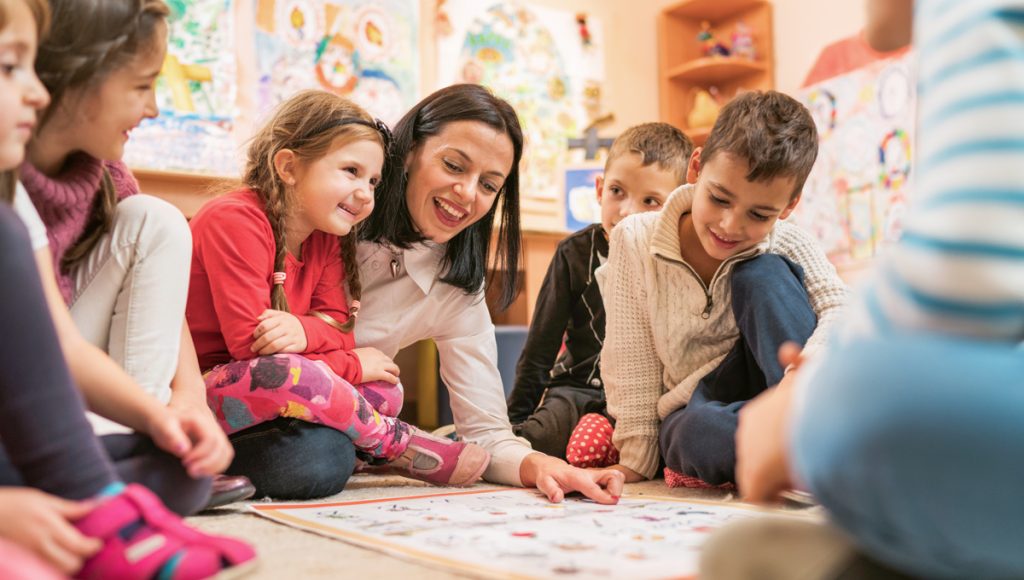What Makes A Positive Learning Environment

UPDATE: Read our latest commodity "3 Ways to Foster a Positive Classroom Climate" written by Kim Gulbrandson, Ph.D.
I've been hearing a lot about "positive classroom climate." What does this mean?
Classroom climate refers to the prevailing mood, attitudes, standards, and tone that you and your students feel when they are in your classroom. A negative classroom climate can feel hostile, chaotic, and out of control. A positive classroom climate feels condom, respectful, welcoming, and supportive of student learning.
Simply there's not much I can do nearly the classroom's climate, right? I get the students I get!
The good news is that a classroom's climate doesn't just happen—information technology'due south created! Regardless of your students' by experiences, there are things you can do to deliberately shape the climate of your classroom into a positive learning surround.
That's great news! What tin I do to create a positive classroom climate?
To create a positive climate for your classroom, focus on the following three "pieces" of the classroom climate "pie:"
Positive Classroom Climate
- Develop and reinforce classroom rules and norms that conspicuously support safe and respectful behavior. Having classroom rules helps you create a predictable, safe learning surround for your students. Rules give your students clear boundaries and opportunities to practice self-regulation and make practiced choices. When students experience safety and respected both emotionally and physically, they are able to focus better on learning.
- Promote positive peer relationships. You want to create an environment where your students support and are kind to one some other. Some ways you can do this are:
- Notice and reinforce casual positive interactions betwixt students on a daily basis.
- Deliberately plan relationship-building activities and games that encourage positive interactions. These can be long-term projects, or brusk and simple games designed for students to get to know each other meliorate.
- Pay attention to the social dynamics of your classroom. Do some students have trouble making friends? Do some students have trouble getting along with others? Who has a lot of friends? Who has few friends? Interviewing your students one-on-i tin can help yous place students that take stronger or weaker social connections. This can inform your seating arrangements, guide your grouping and pairing decisions, and assist you in helping students form new networks of friends.
- Have form meetings. Class meetings provide a prophylactic environment in which students can discuss with you and each other topics that are important to them. You and your students can go to know each other amend and build relationships through open discussions on subjects like: Following Rules, How to Get Help, Including Others at Recess, Solving Playground Issues, etc. This helps create a positive classroom climate built on trust and respect.
- Nurture positive relationships with all students. You need to let your students know that you not but intendance nearly their progress in the classroom, you also care about them equally homo beings. Some ways yous can do this are:
- Greet your students by name every fourth dimension they walk in the door. This lets them know that you notice and intendance that they are at that place.
- Utilise warm, inclusive behaviors with your face, body, and words each mean solar day. Smiling! Ask, "How are you feeling?" Look at your students. Detect and reinforce their positive behaviors with encouraging words.
- Enquire your students personal questions that will assist yous get to know them and what'southward happening in their lives outside of school. "How was your soccer game last night?" "Is your grandma feeling better?"
- Notice changes in students' physical and emotional behaviors. Changes may bespeak a pupil is in need of additional emotional back up. Provide or find back up for that student as needed.
- Spend and keep runway of individual fourth dimension with each ane of your students over a set elapsing (such as each calendar month).
Is there a mode I can see how well our classroom climate is doing?
Aye! Check in with your students throughout the year during ane-on-one interviews, or ask for their written responses to some of the following types of questions: Do you experience safe in our class? Are students in our form kind to each other? Do students in our grade follow the rules? Do you feel included past the other students? What else would you like me to know almost you lot? Make adjustments every bit necessary based on your students' feedback to ensure a positive learning environment for your students.
What Makes A Positive Learning Environment,
Source: https://www.cfchildren.org/blog/2012/08/key-factors-in-creating-a-positive-classroom-climate/
Posted by: haltertrachattee1941.blogspot.com


0 Response to "What Makes A Positive Learning Environment"
Post a Comment